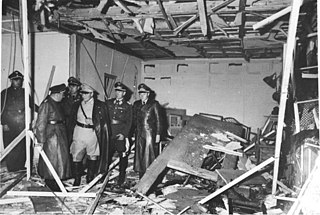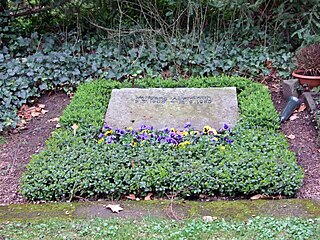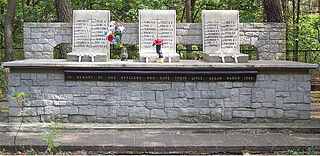 W
WOn 20 July 1944, Adolf Hitler and his top military associates entered the briefing hut of the Wolf's Lair military headquarters, a series of concrete bunkers and shelters located deep in the forest of East Prussia, not far from the location of the World War I Battle of Tannenberg. Soon after, an explosion killed three officers and a stenographer, injuring everyone else. This assassination attempt was the work of Colonel Claus von Stauffenberg, an aristocrat who had been severely wounded while serving in the North African theater of war, losing his right hand, left eye, and two fingers of his left hand.
 W
WOn 22 June 1944, the Soviet Armed Forces launched a massive attack against the German forces based in Belorussia, which were made up of two strategic Wehrmacht army groups known as Army Group Centre. By mid July, Army Group Centre had lost no fewer than 250,000 men in less than a month of fighting, making the German position close to hopeless.
 W
WThe Auschwitz concentration camp complex was a system of concentration camps run by Nazi Germany in occupied Poland from 1940 to 1945. The main camp was Auschwitz I. Auschwitz II, or Birkenau, was a concentration and extermination camp, and became the most notorious of the camps. Auschwitz III, or Monowitz, was a labour camp.
 W
WThe Beer Hall Putsch, also known as the Munich Putsch, was a failed coup d'état by Nazi Party leader Adolf Hitler, Generalquartiermeister Erich Ludendorff and other Kampfbund leaders in Munich, Bavaria, on 8–9 November 1923, during the Weimar Republic. Approximately two thousand Nazis marched on the Feldherrnhalle, in the city centre, but were confronted by a police cordon, which resulted in the deaths of 16 Nazi Party members and four police officers.
 W
WPolitical decorations of the Nazi Party were medals and awards issued by the National Socialist German Workers Party (NSDAP) between 1920 and 1945. Political awards were authorized for wear on any paramilitary uniform of Nazi Germany, as well as civilian attire, but were generally discouraged on Wehrmacht military uniforms. The Waffen-SS freely wore both political awards and military decorations on their uniforms.
 W
WThis is a list of notable Nazi medical doctors (physicians).
 W
WThe Gaue were the main administrative divisions of Nazi Germany from 1934 to 1945.
 W
WThis list contains the names of individuals involved in the German resistance to Nazism, but is not a complete list. Names are periodically added, but not all names are known. There are both men and women on this list of Widerstandskämpfer primarily German, some Austrian or from elsewhere, who risked or lost their lives in a number of ways. They tried to overthrow the National Socialist regime, they denounced its wars as criminal, tried to prevent World War II and sabotaged German attacks on other countries. Some tried to protect those who were being harmed and persecuted by the Nazis, others merely refused to contribute to the Nazi war effort. Most of those on the list worked with others; their affiliated resistance group or groups are listed. Where no group is mentioned, the individual acted alone.
 W
WThe "Great Escape" was a World War II mass escape from the German prisoner-of-war camp Stalag Luft III. It resulted in the execution of 50 recaptured escapees.
 W
WAdolf Hitler, as Führer and Reich Chancellor and Supreme Commander of the Armed Forces of Nazi Germany, employed a personal staff, which represented different branches and offices throughout his political career. He maintained a group of aides-de-camp and adjutants, including Martin Bormann's younger brother Albert in the National Socialist Motor Corps (NSKK), Friedrich Hoßbach of the Wehrmacht, who was sacked for unfavourable conduct, and Fritz Darges of the Schutzstaffel (SS), who was also dismissed for inappropriate behaviour. Originally an SS adjutant, Otto Günsche was posted on the Eastern Front from August 1943 to February 1944, and in France until March 1944, until he was appointed as one of Hitler's personal adjutants.
 W
WThis list includes both authors whose entire literary production was officially banned in Nazi Germany and authors who were only partially banned. These authors are from the prohibitions lists in Nazi Germany and come from the following lists and others:List of damaging and undesirable writing, Liste des schädlichen und unerwünschten Schrifttums, December 31, 1938 Jahreslisten 1939-1941. Unchanged new printing of the Leipzig edition, 1938-1941, Vaduz 1979
 W
WAt the Moscow Victory Parade of 1945, marking the defeat of Nazi Germany, there were a total of 201 German cavalry standards and combat banners, majority being from the Wehrmacht. Carried by a battalion of Soviet soldiers from the Separate Operational Purpose Division of the NKVD, they were thrown to the steps of Lenin's Mausoleum under drumroll during the march past of the ground column. Around twenty standards at the parade were not Nazi and belonged to previous German units. All the rest were made in 1935. Among them was the standard staff of the 1st SS Panzer Division Leibstandarte SS Adolf Hitler (LSSAH); its banner had been found separately and was not brought to the parade. The staff was carried in a prominent place on the right of the front rank of the first column of soldiers. It has been incorrectly called Hitler's personal standard which went missing during the war. After the parade additional color shots were made showing the flags of various Nazi organizations being thrown to the ground. The shots were added to the official video of the parade.
 W
WThis is a list of subcamps of the Mauthausen concentration camp. The slave labour of the inmates was also used by a variety of companies and farms that accommodated a small number of inmates on their own.
 W
WThis is a list of Nazi Party (NSDAP) leaders and officials.
 W
WThe following, is the list of subcamps of the Ravensbrück concentration camp complex built and run by Nazi Germany during World War II. By 1944 Ravensbrück consisted of a system of between 31, and 40, and up to 70 subcamps, spread out from Austria to the Baltic Sea, with over 70,000 predominantly female prisoners. It was the only major Nazi camp for women.
 W
WThis list of speeches given by Adolf Hitler is an attempt to aggregate Adolf Hitler's speeches. From his first speech in 1919 in Munich until the last speech in February 1945 he gave a total of 1525 speeches. In 1932, for the campaign of two federal elections that year he gave the most number of speeches, that is 241. It is not possible to list all of them, so only 123 of his notably important speeches have been listed here.
 W
WThis is a partial list of streets and squares named after Adolf Hitler during the era of Nazi Germany.
 W
WThis is a list of suicides in Nazi Germany. Many prominent Nazis, Nazi followers, and members of the armed forces died by suicide during the last days of World War II. Others killed themselves after being captured. Those who committed suicide includes 8 out of 41 NSDAP regional leaders who held office between 1926 and 1945, 7 out of 47 higher SS and police leaders, 53 out of 554 Army generals, 14 out of 98 Luftwaffe generals, 11 out of 53 admirals in the Kriegsmarine, and an unknown number of junior officials.
 W
WTo carry out the planned V-1 "flying bomb" attacks on the United Kingdom, Germany built a number of military installations including launching sites and depots. Some of the installations were huge concrete fortifications.
 W
WThe list of V-2 test launches identifies World War II launches of the A4 rocket. Test launches were made at Peenemünde Test Stand VII, Blizna and Tuchola Forest using experimental and production rockets fabricated at Peenemünde and at the Mittelwerk. Post-war launches were conducted at Cuxhaven, White Sands Proving Grounds, Cape Canaveral, Kapustin Yar, and on the USS Midway during Operation Sandy.